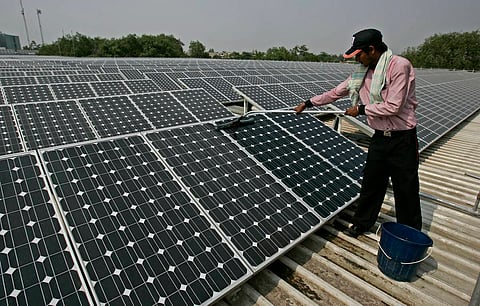

When it comes to renewable energy, the Union government spends the most on the production of solar energy. Despite this, it has managed to achieve only about 12 per cent of the total installed capacity so far.
The country’s total solar capacity is approximately 748,990 megawatts (MW), but only 90,760 MW has been installed by September 30, 2024, while the government has set a target of 292,000 MW by 2030.
The Parliamentary Standing Committee on Energy has raised several important questions in its second report on the Union Ministry of New and Renewable Energy’s (MNRE) demand for grants (2024-25).
The committee has called the efforts to generate power from solar energy as well as other renewable energy sources inadequate. It has also made stern remarks about the ministry’s Budget.
Reacting to the ministry’s efforts regarding solar energy, the committee noted, “The progress of solar energy-related projects in the country has not been satisfactory so far. Compared to the total solar capacity of 748,990 MW, only 89,432 MW has been installed by August 31, 2024.”
The Standing Committee has also scrutinised various solar energy schemes. Regarding the government’s biggest solar energy initiative this year, the PM Surya Ghar: Muft Bijli Yojana, the committee expressed dissatisfaction with its pace.
The highest allocation in the Budget 2024-25 has been made for the scheme. The estimated Budget for this scheme is Rs 6,250 crore, with a target to install solar systems on 2.5 million rooftops throughout the year.
The government’s goal under the PM Surya Ghar: Muft Bijli Yojana is to install solar systems on 10 million homes by 2026-27, with a total financial provision of Rs 75,021 crore. The ministry claims that this will generate 100 billion units of electricity and reduce carbon dioxide emissions by 72 million tonnes.
In a meeting held on October 15, 2024, the ministry’s secretary informed the standing committee members that 14 million registrations had been completed so far, with two million applicants and 480,000 houses having solar panels installed.
Of these, 280,000 people have already received subsidies.
The secretary justified the slow pace of this work by attributing delays to the monsoon. However, the department has claimed that three to three and a half thousand solar panels are being installed daily. They expressed hope that the target of 1.2 million homes will be easily achieved by the end of the year.
The committee, however, commented, “The pace of the scheme’s implementation is very slow. By October 2024, out of the nearly 2 million applications on the portal, only 500,000 rooftop solar panels have been installed. Of these, subsidies have been distributed to only 300,000.”
The Standing Committee’s report mentioned that the ministry had estimated a Budget requirement of Rs 12,001.70 crore for the financial year 2024-25, whereas Rs 21,230 crore was actually allocated. This amount is nearly 170 per cent more than the revised estimate for the previous year. However, in the past years, the ministry has not been able to fully utilise the allocated budget.
The report indicates that the Budget utilisation in the financial years 2021-22, 2022-23, and 2023-24 was about 88 per cent, 82 per cent, and 83 per cent, respectively.
The ministry cited two main reasons for the under-utilisation of the Budget: first, the impact of two consecutive waves of the COVID-19 pandemic, and second, insufficient project proposals from the northeastern states.
The report also found that the Budget utilisation in the northeastern regions during 2021-22, 2022-23, and 2023-24 was disappointing, with only 13 per cent, 2 per cent, and 4 per cent, respectively.
While the ministry is focusing on solar energy, other sources of energy are being neglected. As stated in the report, approximately 87 per cent of the ministry’s Budget has been allocated solely for solar energy. Under the solar energy component, nearly 72 per cent of the budget is designated for implementing the scheme.
Around four per cent of the Budget has been allocated to settle pending liabilities related to wind and small hydroelectric projects, while about 1 per cent is for the National Bioenergy Programme. The Budget for the National Green Hydrogen Mission and Green Energy Corridors is approximately three per cent, with the remaining 2 per cent allocated for research and development, infrastructure, local bodies, and support programmes.
The ministry informed the committee that it is working towards achieving 500 GW of installed capacity from non-fossil sources by 2030. As of 30th September 2024, the country has installed a total of 209.63 GW of non-fossil fuel-based electricity capacity, which includes 201.45 GW from renewable energy (including large hydroelectric power) and 8.18 GW from nuclear power.
As of September 30, 2024, non-fossil energy contributes 46.31 per cent to the total installed electricity capacity of 452.7 GW.